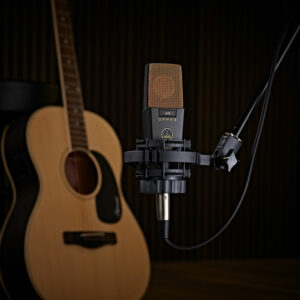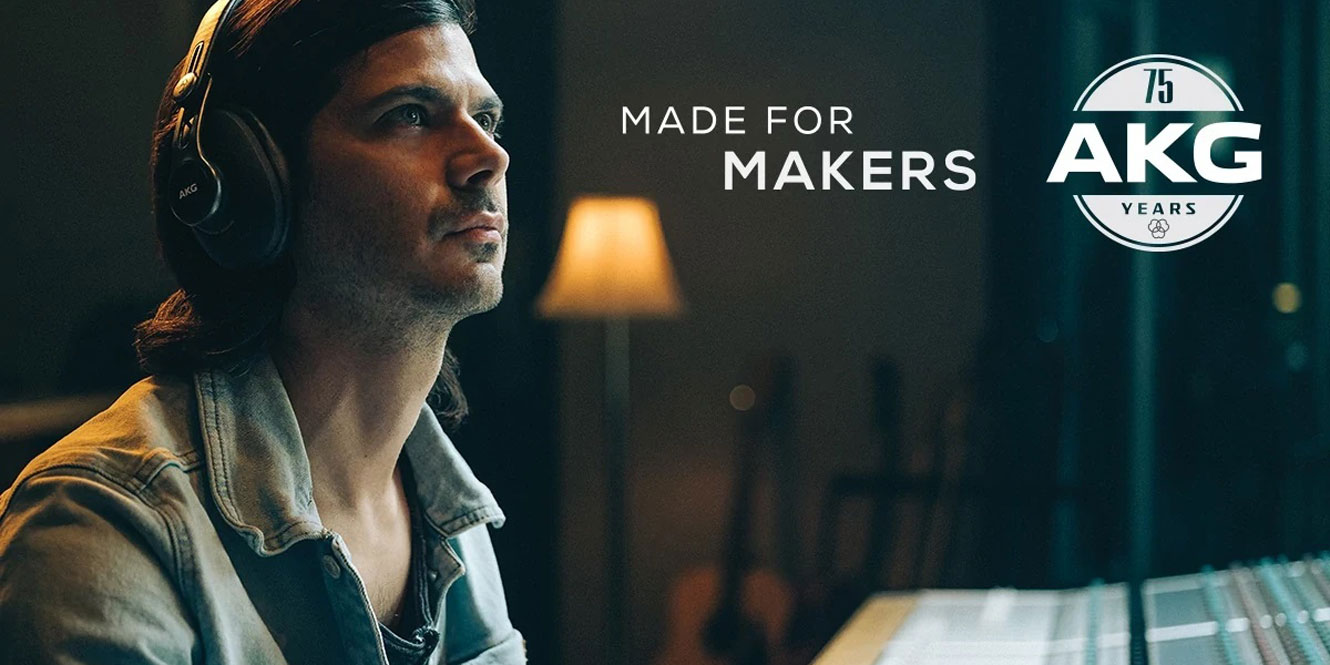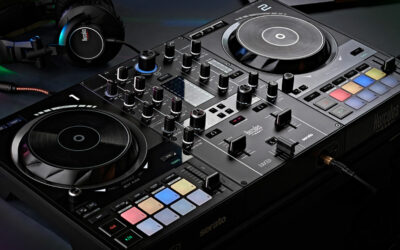Austrian manufacturer AKG Acoustics recently celebrated their 75th anniversary. So, to acknowledge the years of their consistent innovation and rich history, we’re taking a look at their origins, notable inventions, and current offerings.
Key milestones in AKG’s history
- AKG were founded in Vienna in 1947 by Rudolf Görike and Ernst Pless, two old friends who reconnected after World War II.
- The two founders and five other core employees began designing, producing, and selling modified film projectors and loudspeakers for Vienna’s movie theatres. They then expanded to design and sell other audio-related products, such as car horns, cushion speakers, intercoms, and telephone capsules.
- AKG designed their DYN series in 1949 and it comprised dynamic microphones and headphones, such as K120 DYN headphones.
- In 1953, AKG produced the D12, the world’s first cardioid dynamic microphone with a single diaphragm. It became a favourite, primarily for vocals, but also for instruments in radio stations, film recording, and recording studios.
- Also in 1953, AKG designed the legendary CK12 condenser capsule and placed it in the compact pencil-shaped housing of the C12, with a tube-based amplification stage at the request of the Austrian national radio network.
- In 1959, AKG created the world’s first-ever open-back headphones, the K50.
- Throughout the 1960s, AKG would use the CK12 capsule to design various microphones. The C24, C414, and collaborations with Telefunken in the form of the Ela M 250 and M 251 are some of the most notable examples.
- In 1970, AKG released the BX20, a spring reverb processor that became widely adopted in recording studios.
- AKG produced other world firsts in the ’70s and ’80s like hybrid dynamic/electrostatic headphones (K340), binaural headphones (K1000), and the first wireless headphones (the Libero series).
- in 1994, Harman acquired AKG and focused production on their core products: headphones and microphones.
- In 2010, AKG received a Technical Grammy Award for their contributions to recording technology over the last 63 years.
- AKG continue to innovate and change with the times, creating more new microphones, headphones, and wireless systems.
75 Years of AKG Innovation
 AKG were formed in Vienna by old friends, physicist Rudolf Görike and engineer Ernst Pless, who reconnected after World War II in 1947. The company stem from humble origins – designing and selling their own loudspeakers and modified film projectors to local movie theatres throughout Vienna.
AKG were formed in Vienna by old friends, physicist Rudolf Görike and engineer Ernst Pless, who reconnected after World War II in 1947. The company stem from humble origins – designing and selling their own loudspeakers and modified film projectors to local movie theatres throughout Vienna.
With a core team of five employees in addition to Görike and Pless, AKG would deliver these products on bicycles or in wheelbarrows, accepting payment in butter, meat, and cigarettes.
It wasn’t long before AKG started to garner more attention for other common audio products such as car horns, intercoms, telephone handset capsules, and cushion speakers to follow the trends of the time.
By 1949, they turned their focus to headphones and microphones, releasing the K120 DYN headphones and the C1 tube condenser microphone.
1953 marked two extremely notable releases for the company. The first was the D12 dynamic microphone, which became the first single-diaphragm cardioid dynamic microphone.
Quickly adopted for its warm frequency response, which reduced the harshness of many of its contemporaries, the D12 became a fast favourite for radio stations, film sets, and recording studios, where it would be used mainly on vocals and sometimes instrument recordings.
The D12 would go on to inspire many of AKG’s future innovations, including the modern and popular kick drum and bass microphone, the D112, which added a 4 kHz presence boost to pick up more attack. This has also been the driving force behind the D12VR, which is still available today, taking a classic approach with some modern adjustments.
Next was the C12 tube condenser microphone. This high-end mic’s uniquely thin and cylindrical shape was requested by the Austrian national radio network RAVAG which wanted ‘a microphone as thin as a pen’. This mic was also the first to house AKG’s unique CK12 capsule, which became the foundation of many of AKG’s condensers that followed, even to this day.
The reason for this capsule’s enduring popularity is its transparency and balanced sound. It’s great for imparting character through tube amplification, like in the C12 and various other tube condensers, or providing an extremely full yet balanced recording that translates sound sources incredibly accurately.
It has a consistent frequency response and sensitivity across all polar patterns, which makes it very adaptable to all kinds of designs.
The CK12 would go on to be adapted into the stereo C24, the C412, and many other popular tube condensers from manufacturers like Siemens and Telefunken, including the Ela M 250 and M 251. One that’s still available and incredibly popular today is the C414, which takes full advantage of the CK12’s consistent response with different polar patterns by offering a full variety of them, with nine different switchable options.
The C414 has become an enduring large-diaphragm condenser within studios.
AKG introduced all-new technology to the world of audio with the K50 headphones, the world’s first set of open-back headphones. This technology is still used for high-end monitoring and Hi-Fi listening to this day.
In the intervening years, AKG continued to come up with new products, like the BX20 spring reverb in 1970, which became an extremely popular reverb unit in recording studios. However, their focus turned back to headphones.
During this time, the pioneering Austrian manufacturer came up with a string of world firsts: the first hybrid dynamic and electrostatic driver-based headphones, the K340; the first wireless headphones, the Libero series; and the first binaural headphones, the K1000.
In the following years, AKG was acquired by Harman. They shifted their main manufacturing to California and continued to innovate, integrate and advance new technologies like Bluetooth headphones and USB microphones. In 2010, AKG was awarded a Technical Grammy Award for their contributions to studio recording technology.
Microphones and headphones
 So, what do AKG’s modern offerings have to show? Frankly, just about anything you could want for headphones and microphones.
So, what do AKG’s modern offerings have to show? Frankly, just about anything you could want for headphones and microphones.
They offer high-end studio condensers, both clear and vintage; transformer and tube-based mics alike; versatile dynamic microphones that do well on live vocals and louder instruments in the studio; USB mics perfect for demo recording, content creation, and general home use; high-grade monitoring headphones; consumer Hi-Fi headphones; and Bluetooth headphones. Phew!
All of AKG’s products build on the legacy of their past designs, with a focus on neutrality and accuracy.
Their K240 headphones utilise the same open-back design that AKG are known for inventing, offering a tight, focused design at an extremely inviting price point, a perfect option for home studio monitoring and casual listening alike.
The AKG K371 is a set of closed-back headphones with excellent sensitivity and an incredible frequency response. Covering 5 Hz to 40 kHz, every frequency within the range of human hearing is reproduced accurately and smoothly, by going far beyond it to prevent any aliasing or frequency cramping.
Perfect for monitoring, tracking, DJing, and casual listening, these headphones are seen in bedrooms, project studios, stages, and professional recording spaces across the world.
A modernised take on their classic C414 condenser microphone, the C414 XLS is a warm, classically-voiced version of this recording workhorse. Removing the transformer from some previous versions, and released alongside the C414 XLII, this is an alternative take with an extended top-end.
Both the XLS and XLII deliver accuracy and transparency. But if you’re looking for a sound that’s a little closer to the original, the XLS is more vintage, whereas the XLII is modern. However, both take full advantage of the CK12 capsule’s defining strength: its adaptability to polar patterns, letting you select between nine different options.
Whichever version you prefer, this microphone has been a go-to ever since 1971, and once you hear it in action, this should come as no surprise.
Artists and producers who use AKG
AKG products have been used by a wide range of notable artists and producers, from musicians like Frank Sinatra, The Rolling Stones, Peter Gabriel, and Billy Idol to legendary producers like The Beatles’ producer George Martin, as well as well-known engineers Al Schmitt and Bruce Swedien.
Famed producer Quincy Jones has even collaborated with AKG on a set of limited-edition monitoring headphones, with uniquely designed drivers. Jones is known for his work with Ray Charles, Aretha Franklin, Frank Sinatra, and Michael Jackson – to name just a few! He is a consistent user of their mics and headphones alike.

FAQs
Is AKG owned by Samsung?
AKG have been owned by Harman International since 1994, which became a subsidiary of Samsung Electronics in 2016. So, whilst most of the day-to-day operation of AKG is more involved with Harman, its parent company is Samsung.
Is AKG a good brand?
Yes, AKG makes some great-sounding microphones and headphones. Their products cover a wide range of budgets and sounds to fit what you’re looking for, and they’re built to a high standard. Their headphones and microphones have been used in professional recording studios, budget home studios and content creation spaces and for casual listening.
What does AKG stand for?
AKG stands for “Akustische und Kino-Geräte Gesellschaft”, the company’s original name in German. Translated to English, this name means “Acoustic and Cinema Equipment”, which goes back to the origins of the company and the equipment they originally sold.
Final thoughts
AKG products are legendary, hence their wide use across professional recording contexts. The CK12 capsule found in many of their higher-end microphones has developed a huge reputation for even sensitivity and frequency response across different polar patterns. Plus, in the world of headphones, AKG have pioneered many of the technologies that have defined high-grade monitoring headphones today.
And with 75 years of experience behind them, AKG’s products only continue to get better and better!





Fantastic